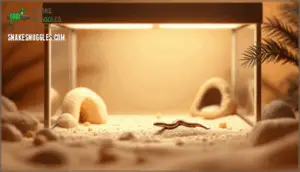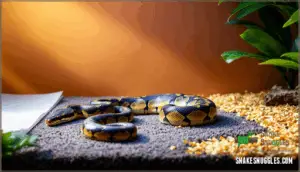This site is supported by our readers. We may earn a commission, at no cost to you, if you purchase through links.
 Your first baby snake arrives in three days, and you’re suddenly realizing that "small" doesn’t mean "simple." These fragile neonates need precision—wrong substrate can trigger respiratory distress, improper humidity causes stuck sheds, and temperature errors shut down their digestive systems entirely.
Your first baby snake arrives in three days, and you’re suddenly realizing that "small" doesn’t mean "simple." These fragile neonates need precision—wrong substrate can trigger respiratory distress, improper humidity causes stuck sheds, and temperature errors shut down their digestive systems entirely.
Unlike adult snakes that tolerate husbandry mistakes, hatchlings operate within narrow survival margins. The difference between thriving and failing often comes down to decisions you make before they even arrive.
Getting the enclosure, feeding protocol, and monitoring systems right from day one determines whether your snake transitions smoothly into captivity or struggles with preventable health crises.
Table Of Contents
- Key Takeaways
- Preparing The Enclosure for Baby Snakes
- Temperature and Humidity Control Essentials
- Feeding and Hydration for Newborn Snakes
- Ensuring Safety and Minimizing Stress
- Routine Health Checks and Ongoing Maintenance
- Frequently Asked Questions (FAQs)
- How long do Baby Snakes take care of?
- Can baby snakes eat their young?
- When should you handle a new hatched snake?
- When to expect Baby Snakes to hatch from their eggs?
- Should you raise a pet snake yourself?
- What temperature should a snake eat?
- What permits or licenses are needed for owning baby snakes?
- How do you identify the species of your baby snake?
- Can baby snakes be housed together safely?
- What are the estimated monthly costs for baby snake care?
- Conclusion
Key Takeaways
- Baby snakes operate within narrow survival margins where precision in substrate choice, humidity levels (60-75%), and temperature gradients (75-85°F) directly determines whether they thrive or develop preventable respiratory distress, digestive shutdown, or shedding complications.
- Hatchlings require minimal handling for the first 3-5 days post-arrival to avoid cortisol spikes of up to 40%, with proper enclosure setup including dual hides, appropriate ventilation, and safe substrates like aspen shavings or coconut fiber being critical before they arrive.
- Feeding protocols should wait 5-10 days after birth while the yolk sac provides nutrients, then begin with prey sized at roughly 10% of body weight (typically 1-2 gram pinkie mice), with frozen options reducing parasite risk compared to live prey.
- Daily monitoring of temperature gradients, humidity levels, feeding responses, and stress signals like defensive posturing or feeding refusal prevents health crises, while the first veterinary exam within seven days establishes a baseline for detecting congenital issues early.
Preparing The Enclosure for Baby Snakes
Setting up the right enclosure isn’t just about picking any tank—it’s about creating a safe space where your baby snake can thrive from day one. You’ll need to make decisions about size, materials, airflow, and interior setup before bringing your new snake home.
Let’s walk through the key elements that make an enclosure work for these fragile hatchlings.
Choosing The Right Tank Size and Material
Your first major decision—picking the right tank—sets the foundation for everything your baby snake will experience in those critical early weeks. A glass aquarium with a screen top works well for most hatchlings, offering clear visibility and temperature control.
You’ll want an enclosure that’s cozy but not cramped—usually a 10-gallon terrarium suits most newborns. Plastic or fiberglass cages are viable alternatives, though they require attention to airflow and cleaning access.
Setting Up Secure Ventilation
Once the tank is in place, proper airflow becomes your next checkpoint—without it, you’re inviting respiratory problems and bacterial growth. Screen tops on glass aquariums provide excellent ventilation systems while maintaining security.
If you’re using plastic tanks, verify multiple breathing spaces exist to promote airflow management. Stagnant air compromises humidity control and enclosure design, so position vents strategically—your reptile habitat depends on consistent air exchange to stay healthy.
Selecting Safe Substrate Options
The floor of your enclosure matters more than you might think—choose the wrong material, and you’ll deal with impaction, bacterial blooms, or respiratory distress. Safe substrate choices protect your snake’s respiratory health and digestive system.
Here are proven bedding options for snake enclosures:
- Aspen shavings – excellent humidity control and easy to spot-clean
- Coconut fiber – maintains moisture without clumping
- Paper towels – sterile, affordable, simple to replace
- Cypress mulch – natural moisture retention for tropical species
- Newspaper – cost-effective for temporary quarantine setups
Avoid cedar, pine, and sand—these substrate materials cause toxicity and impaction in reptile habitats.
Creating Multiple Hiding and Nesting Spots
Baby snakes won’t thrive without proper shelter—stress from constant exposure triggers feeding refusal and suppresses immune function. Place at least two hides per enclosure—one on the warm side, one on the cool side. Use opaque materials like cork bark, half-logs, or commercial reptile hides for visual barriers.
Proper nesting areas give your snake security while you monitor its habitat without constant disturbance.
Temperature and Humidity Control Essentials
Your baby snake’s survival depends on getting the temperature and humidity just right. These two factors work together to support healthy growth, proper digestion, and successful shedding.
Let’s look at the specific tools and techniques you’ll need to maintain these critical conditions.
Establishing Proper Temperature Gradients
Your baby snake can’t regulate its own body temperature, so you’ll need to create a warm zone and a cool zone inside the enclosure to let it choose what feels right. Set your thermal gradient between 75-85°F using heat sources like under-tank heaters or ceramic bulbs.
The warm end aids digestion and activity, while the cool end prevents overheating. This temperature control for snakes mimics natural thermoregulation techniques they’d use in the wild.
Check both zones daily—gradient maintenance keeps your snake healthy and stress-free.
Monitoring and Adjusting Humidity Levels
Beyond mere temperature control, humidity control is your second nonnegotiable safeguard for baby snake health. Keep levels between 60–75% using a digital hygrometer placed mid-enclosure for accurate readings. Adjust by misting daily, adding moisture-retentive substrate like coconut fiber, or improving ventilation systems if levels climb above 80%.
Humidity fluctuations exceeding 20% daily trigger stress and feeding refusal, so check your hygrometer twice daily and recalibrate monthly for reliable reptile husbandry. For essential care, understanding reptile monitor systems is vital.
Recommended Thermometers and Hygrometers
Accurate instruments transform guesswork into precision—invest in a digital thermometer-hygrometer combo unit with dual probes to monitor both temperature and humidity simultaneously. Position temperature probes at both the warm and cool ends to verify proper temperature gradients, while placing precision hygrometers mid-enclosure for representative humidity levels.
Essential features include:
- Wireless monitoring for remote tracking without disturbing your snake
- Dual temperature probes measuring basking and cool-side zones
- Memory functions recording daily highs and lows
- Calibration capability guaranteeing long-term accuracy
- Humidity sensors with ±3% precision or better
Replace batteries quarterly and recalibrate monthly for reliable data.
Feeding and Hydration for Newborn Snakes
Feeding newborn snakes properly guarantees their survival and healthy development. You’ll need to understand when to start offering meals, what prey suits their size, and how to keep them hydrated safely.
Here’s what you need to know about nourishing your baby snake from day one.
When to Offer The First Meal
Most newborn snakes don’t need to eat right away—they come equipped with a built-in lunch in the form of their yolk sac. This nutrient reserve sustains them for several days to a week after birth.
Watch for feeding cues like active tongue-flicking and exploratory activity before offering the first meal. Initial offering timing depends on species, but most baby snakes are ready within 5-10 days.
Following proper snake feeding guidelines helps your hatchling transition smoothly to independent feeding.
Selecting Appropriate Prey Types
Prey selection can feel like choosing the perfect key for a lock—get the size wrong, and feeding baby snakes becomes frustrating. Start with pinkie mice (1–2 grams) for most species, matching prey items to roughly 10% of your snake’s body weight.
Frozen food benefits include safer management and reduced parasite risk compared to live prey risks like bites or stress. Species preferences matter—garter snakes need insects, while ball pythons thrive on rodents.
Proper snake diet and feeding guarantees nutrient balance for healthy growth. For ideal feeding, consider the feeder mouse guide to determine the best size for your snake.
Providing Shallow Water Dishes
A water dish isn’t just about hydration—it’s a lifeline that prevents dehydration and aids healthy shedding in baby snakes. Follow these hydration essentials for snakes:
- Water Bowl Placement: Position the shallow water dish on the cool side to prevent excessive evaporation.
- Bowl Safety: Choose low-sided dishes to prevent drowning—depth should match your snake’s body width.
- Water Quality: Replace daily with fresh, dechlorinated water.
- Dish Cleaning: Scrub weekly with reptile-safe disinfectant to prevent bacterial growth.
Troubleshooting Feeding Challenges
Getting your baby snake to eat isn’t always straightforward—some refuse their first meal, and that’s when you’ll need smart strategies to turn things around. Try feeding schedules at dusk when nocturnal species hunt naturally.
If food refusal persists, warm pinkie mice under hot water to intensify scent for appetite stimulation. Offering prey in complete darkness often triggers feeding responses.
These feeding techniques for newborn snakes address snake nutrition concerns without force-feeding—patience wins here.
Ensuring Safety and Minimizing Stress
Baby snakes are delicate creatures that can become stressed quickly if their environment isn’t right. Stress weakens their immune systems and disrupts feeding, so creating a calm, secure space is essential.
Let’s look at three key ways to keep your hatchlings safe and comfortable.
Recognizing Signs of Stress in Baby Snakes
Stress conduct in baby snakes can compromise snake health if you don’t catch it early. Watch for increased hiding, reduced tongue flicking, or erratic movements—these appear in 60-70% of stressed juveniles. Defensive posturing like striking happens in 75% of acutely stressed hatchlings.
Feeding refusal affects roughly half of baby snakes during environmental stressors, while elevated corticosterone levels show up in 80% after repeated disturbances. Recognizing behavioral cues in snakes helps you address physiological signs before they escalate.
Gentle Handling Techniques
Once you’ve spotted those stress signals, you’ll want to keep your hands to yourself for at least 3-5 days—touching a baby snake too soon can spike cortisol levels by 40% and set back your trust-building efforts.
When you’re ready, support the snake’s body along its length using both hands—gentle touch matters here. Avoid gripping or restraining; let it move freely between your palms. These touch techniques respect snake mannerisms and build trust while prioritizing snake safety.
Maintaining Privacy and Reducing Disturbance
Beyond careful management, your baby snake needs quiet time to feel truly safe. That means limiting how often you peek, rearrange decor, or hover around the tank. Visual barriers like plants or cork bark create private enclosures that reduce stress. Secure lids prevent escapes, while snake hideaways offer refuge from stimulation. Keep noise low and resist frequent management—the importance of privacy for snakes can’t be overstated during these vulnerable early weeks.
Routine Health Checks and Ongoing Maintenance
Keeping baby snakes healthy means staying on top of regular maintenance and watching for early warning signs. You’ll need a consistent schedule for cleaning their space and checking them over for any problems.
Let’s break down what you should be doing to keep your hatchling thriving.
Cleaning and Disinfecting The Enclosure
Keeping your baby snake’s enclosure clean is your first line of defense against bacterial infections and respiratory disease. Remove waste and uneaten prey daily using spot-cleaning techniques. Perform a full enclosure sanitizing every two to four weeks using reptile-safe disinfecting solutions. Replace substrate completely during deep cleaning schedules. Rinse all surfaces thoroughly after disinfection methods to protect your snake’s delicate respiratory system. These hygiene practices guarantee your habitat remains safe for proper reptile care.
Monitoring for Health Issues
Vigilance during the first weeks protects your baby snake from preventable illnesses. Watch for these health indicators during routine health checks:
- Respiratory issues: Open-mouth breathing, wheezing, or clicking sounds signal bacterial infection
- Dented eye caps: Sunken appearance indicates dehydration or incomplete shedding
- Weight loss: Drops exceeding 10% of body mass require immediate veterinary care
- Digestive problems: Diarrhea or no fecal output for two weeks suggests illness
- Reduced tongue flicking: Decreased activity signals environmental stress or snake diseases
Track hydration, feeding responses, and stool consistency in a logbook. Fecal analysis detects snake parasites before symptoms worsen. Regular monitoring facilitates early detection of reptile health problems.
Scheduling Veterinary Visits for Baby Snakes
Your baby snake’s first veterinary exam should occur within seven days of acquisition or hatching—this baseline establishes a health record and catches congenital issues before they escalate.
Schedule follow-up visits every three months during the first year to monitor growth patterns and detect snake health problems early.
A reptile vet with experience in baby snake care provides species-specific guidance on feeding, shedding cycles, and preventive care that protects your newborn’s long-term wellbeing.
Frequently Asked Questions (FAQs)
How long do Baby Snakes take care of?
Here’s the truth: newborn snakes don’t need you. From their first breath, hatchling development runs on instinct alone—no parental care required.
Most juvenile snake needs remain minimal for weeks as they absorb their yolk sacs, making early snake care surprisingly hands-off.
Can baby snakes eat their young?
Snakes don’t exhibit parental care, so adults won’t eat their young. However, filial cannibalism isn’t a concern with newborn snakes.
Cannibalism prevention matters when housing multiple neonates together—kin recognition is poor, and feeding newborn snakes separately prevents accidental predation during meals.
When should you handle a new hatched snake?
Wait a full week before touching — it’s like asking a newborn to run a marathon otherwise. Hatchling development requires undisturbed time to absorb yolk reserves and adjust to their environment.
Gentle touching of snakes begins after this critical acclimation period, safeguarding newborn care respects natural snake behavior patterns.
When to expect Baby Snakes to hatch from their eggs?
Incubation periods vary by species, usually ranging from 45 to 90 days depending on temperature, embryo growth, and breeding cycles.
Most snake eggs hatch between 55 and 75 days at 78-84°F, with hatchlings emerging fully independent and ready for proper newborn snakes care.
Should you raise a pet snake yourself?
Raising reptiles isn’t a shell game—snake ownership demands serious pet responsibility and personal readiness. Before diving into breeding ethics or newborn snake care, ask yourself: Can you commit to decades of reptile care, manage feeding frozen prey, and maintain precise snake habitat conditions?
Baby snake care requires temperature control, proper snake health monitoring, and species-specific knowledge that takes dedication to master.
What temperature should a snake eat?
Snakes should eat prey that’s been warmed to room temperature or slightly above—roughly 75-85°F.
Food temperature matters because snakes rely on thermal cues to recognize prey, and proper ambient heat aids digestion through effective thermal regulation and metabolic function.
What permits or licenses are needed for owning baby snakes?
Reptile licenses and snake permits depend on local wildlife regulations. Many states require breeder registration for snake breeding programs, while some exotic pets fall under stricter exotic ownership laws tied to wildlife conservation and herpetology standards.
Always check your jurisdiction’s specific requirements before acquiring reptiles.
How do you identify the species of your baby snake?
Correctly identifying your snake matters—a misidentified species means wrong temperatures, incompatible prey, or dangerous husbandry mistakes.
Start with morphology analysis: examine scale patterns, head shape, coloration, and body structure. Cross-reference these traits through species research using reliable reptile care guides or breeder verification from your source.
For uncertain cases, genetic testing confirms snake species accurately, safeguarding your species-specific snake care protocols protect your baby snakes from preventable harm.
Can baby snakes be housed together safely?
Most species shouldn’t share enclosures—co-housing newborn snakes increases stress, competition for resources, and risk of cannibalism.
Individual housing guarantees proper monitoring of feeding, health, and safety protocols for each baby snake.
What are the estimated monthly costs for baby snake care?
Your monthly budget usually ranges from $20 to $50, covering food expenses ($10–$20), habitat maintenance substrate and cleaning supplies, equipment upgrades like thermometers, and occasional veterinary costs.
Pet snake care remains affordable, though reptile care information emphasizes emergency funds for unexpected snake health and wellness needs. Snake insurance isn’t common yet.
Conclusion
Picture the moment your snake’s eyes brighten after that first successful shed—crisp, complete, no remnants clinging to scales. That clarity comes from preparing for baby snakes’ arrival with deliberate precision: stable gradients, proper humidity, appropriate prey sizes.
You’ve built an environment where fragile biological processes function smoothly instead of faltering. Now, as your hatchling settles into its hide, breathing evenly and flicking its tongue with curiosity, you’re not scrambling to fix mistakes—you’re watching captive husbandry work exactly as intended.
- https://a-z-animals.com/animals/snake/snake-facts/snake-eggs/
- https://dirtyclassroom.com/snake-reproduction-mallory-schmackpfeffer/
- https://www.reddit.com/r/hognosesnakes/comments/f6gt1n/what_is_the_average_hognose_snake_clutch_size/
- https://www.fhappliances.com/how-to-incubate-snake-eggs-a-complete-guide/
- https://pubs.usgs.gov/publication/5224811














